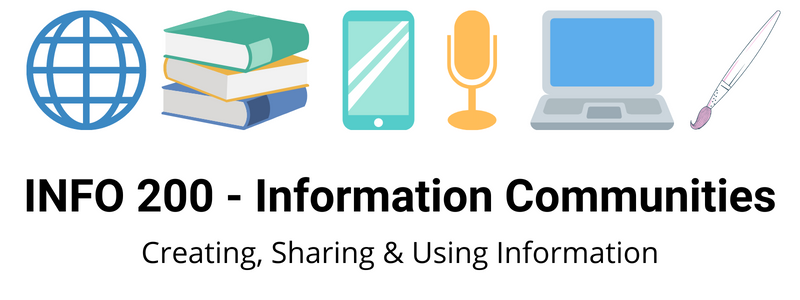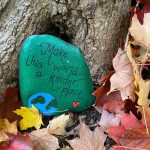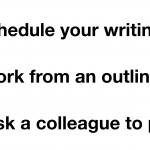Greetings everyone – I want to check in and see how you all are doing and offer some thoughts on the rest of our time together. Here are some action items that may be helpful:
Community Description:
This is an important component of the formal assignments to come.
- LRM: In the first section, in approximately two to four paragraphs, define/describe your chosen Information Community and explain the significance of studying the information behaviors of this group (e.g. why is this research important). This can be an updated and revised version of your Blog Report #2. You are encouraged to use course materials to support your definition.
- Research Paper: Introduction. Identify the information community being studied and why an examination of this group is significant. This opening section should conclude with an overview of what topics related to the information needs and information-seeking behaviors of the community the paper will address.
ACTION ITEMS:
- Work on your community description now which will enable you to remix and reuse it in the LRM and paper.
- Support your description of the community with citations.
- A successful description for the assignments should clearly define the community, identify its information needs and behaviors, and cite foundational literature as well as your own pertinent, peer-reviewed resources. You may also include some statistics from research-based sources, such as Pew, for illustrative purposes.
- Ensure clarity in your writing by using simple, straightforward sentences. Avoid making sweeping generalizations without substantiating evidence.
- Organize your thoughts into categories, such as: “Citizen Scientists seek information, exchange news and insights, and often utilize virtual communities for engaging with their community through discussions and analyses.”
Literature Review Matrix
ACTION ITEMS:
- Use the LRM Assignment page as a guide.
- Paste in your community description and be sure to include all articles cited in the references list.
- Be sure you have 8 peer reviewed studies from LIS or related fields on the info behaviors and needs of your community (or related community) to evaluate in the LRM.
- Strategy: schedule your time to write up one article maybe every 2-3 days. Don’t feel you need to do it all at once. Return to the early ones and see if your thinking has changed.
- Write clear, simple sentences about the articles.
- For the “I Say” portion – write about what reading the article inspired in your thinking about the community and how they look for and use information.
- Use the LRM examples for inspiration.
Blog Reports: Here are some thoughts on the rest of our course blogging.
- Blog Post #5: Explore how libraries and information centers create learning and programming opportunities for your chosen community.
Helper: Explore the professional literature and the resources included in the Teaching and Learning module and write a post related to how libraries and information centers create learning and programming opportunities for your chosen community. What innovative services are in place to support your community’s curiosity? Or suggest some ideas for learning programming based on gaps you discover in services to your group.
- Blog Post #6: Report on the issues your community may face on an international scale.
Helper: Blog Post #6: From your exploration of the literature and the resources included in the Global Librarianship Module, craft a blog post related to the issues your information community may face on an international scale. Consider, for example, how similar info communities to yours seek and create information in the context of their culture. Try to discover whether your international counterparts bring social, gender, environmental and economic justice to light. See if you can share your discoveries and observations in hopes that your experience can prepare and even educate fellow information professionals.
ACTION ITEMS:
- These two can be written by exploring the professional literature (Library Journal, American Libraries, etc) or other resources related to your community.
- Search for articles related to how libraries are offering learning programs for your community and how your community or a related community is being served on the global stage.
- You can actually start these searches now and keep what you find for when you complete the upcoming modules and start writing.
- Write both posts to easily fit into your research paper’s Discussion section, perhaps under headings such as “Learning Programming for Citizen Scientists” and “Library Services Around the World for Citizen Scientists.” This is not self-plagiarism!
Next:
- Blog Post #7: Report on your community’s use of emerging technologies
Helper: Create a media-based artifact (infographic, video, audio, etc) from your research and explorations of your community’s use of emerging technologies. How do they use technology to advance the community or share information? Be as creative as you’d like! Use these “How To” pages at the Community Site:
- How do I add media to pages or blog posts?
- How do I create a media-based artifact?
- Be sure to cite your sources within the artifact or as part of your blog post.
Some popular tools students have used, as compiled by include:
- 16 Best Infographic Tools
- Jing: https://www.techsmith.com/jing.html
- Prezi: https://prezi.com/
- Piktochart: https://piktochart.com/
- Canva: https://www.canva.com/
- Venngage: https://venngage.com/
- Animoto: https://animoto.com/
- Wondershare Filmora: https://filmora.wondershare.com/
- Visme: https://www.visme.co
Also, checkout this helpful site: https://marketingtechblog.com/infographic-layouts/
Please comment below with how you are doing, your own coping strategies and any action items you have for our class, etc. Send questions to me anytime!
Image: Edinburgh’s Advocate’s Close with a view of St. Giles.




Hi Professor Stephens,
I’m not sure if anyone else having a similar issue but when try to view the Literature Matrix Template the link takes me to a page that says I do not have access to view the resource.
@alishacosta Corrected…apologies for that!
Here is the direct link: https://www.dropbox.com/scl/fi/l7dy325wwubzeq05u3im8/LitReviewMatrixTemplate_INFO200Rev5.docx?rlkey=q2pyxl0iv5b1sbot0i73koksn&st=jrt9scs5&dl=0
@michael Thank you so much!
@alishacosta Thanks for the heads up! So many links!!
Hi @Michael !
I am doing good after I used our Spring break to catch up on rest and to slow things down school wise.
The way I like to cope with my school load is by working in small increments so I’ll dedicated a short hour everyday to get something done. If things get too overwhelming I also like to complete tasks based on due date. I won’t try to focus on too many things at the same time, especially if I know there’s a specific assignment due soon.
As far as what is happening in the world, I like to disconnect/unplug as needed. It can be difficult on ourselves to stay informed 24/7 especially when it feels like there’s always something new. Sometimes a short break is all you need to recover.
@omarmolejo03 thank you for sharing your insights on your course workflows and how you deal with the state of the world. I like the idea of scheduling time and honoring that schedule.
Hi @michael! Thank you for preparing these guidelines for us, they are very helpful. The example template for the matrix is quite supportive. I did have a question about the “statement of research” that comes right after the community description. What are the expectations for that part of the matrix? I didn’t find that on our site, but I may have overlooked it.
Thank you!
@angie From the assignment page for the LRM:
For the Statement of Research box, craft a statement regarding your information community and what you want to learn about their information behaviors and needs and how libraries or information centers might provide services to them. For example: The paper based on these articles will demonstrate my understanding of the information behaviors and needs of your chosen community and how libraries and information centers might provide or update services to meet their needs. Customize the statement to reflect your information community.
Thank you!
@angie


Hi! I also stopped by to mention the broken link, and I’m glad to see it’s working now.
After some much-needed relaxing time, I feel more optimistic about my schoolwork. I took a break from social media and the news to decompress from the stressful politics.
Two of my coping techniques are running to get anxious energy out and playing outside with my energetic six-year-old. We both had Spring Break at the same time and went to several parks, the local bookstore, our favorite lunch spot, and a trip to our public library, where we checked out 26 books!
Yesterday, I attended a Writing Center Zoom about Literature Reviews; it was very timely and helpful. I feel better prepared for the LRM.
Thank you for being flexible and responsive!
–
@turnaroundbriteeyes what a nice break you had! I appreciate your sharing about how you manage/cope with also thanks for info on the writing session. That is very cool.
@turnaroundbriteeyes what a nice break you had! I appreciate your sharing about how you manage/cope with also thanks for info on the writing session. That is very cool.